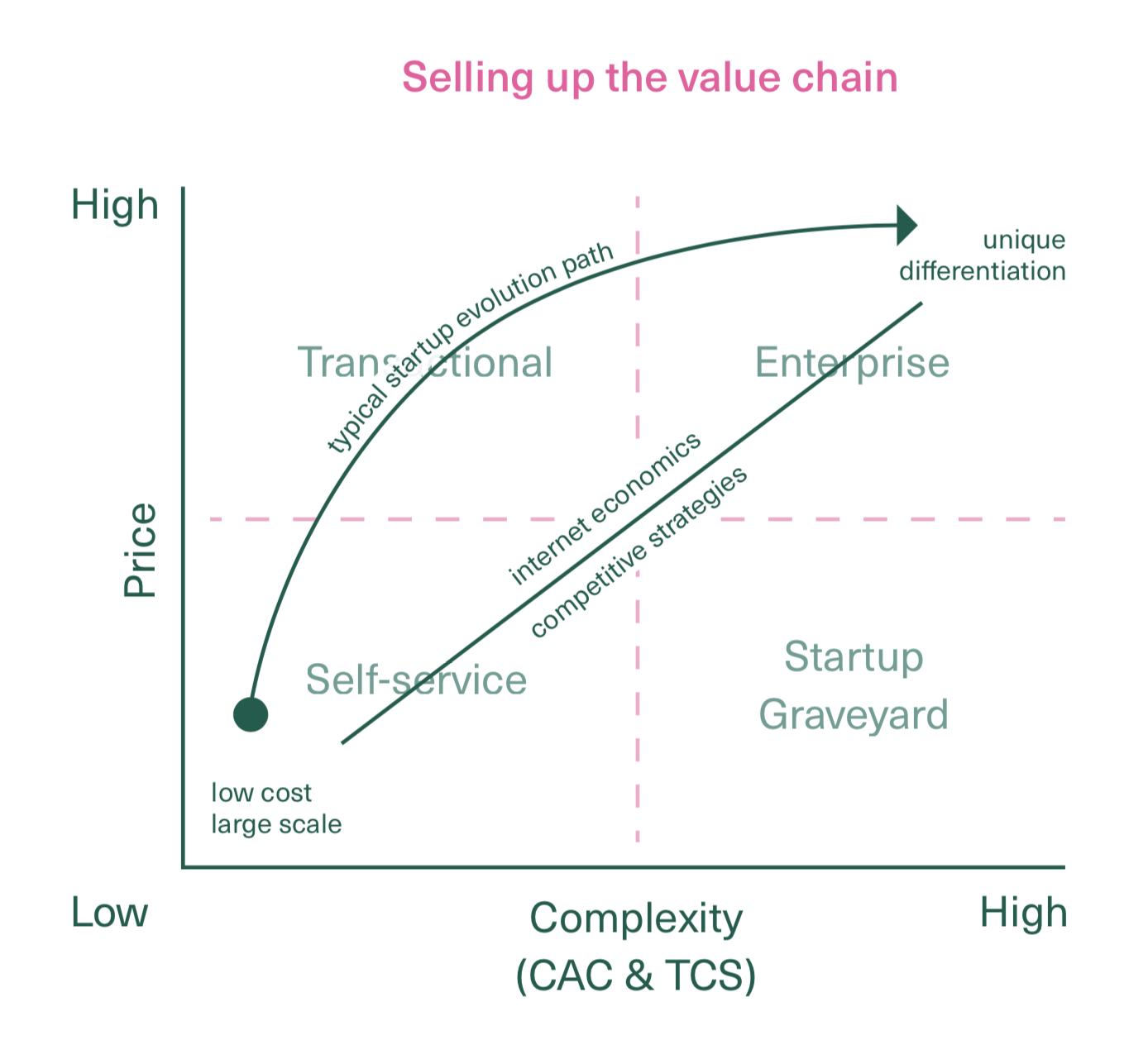
8 steps to create your winning sales strategy, according to industry leaders
Main illustration: Sonny Ross
Developing a successful sales strategy (or plan) is one of the core activities every business will have to undertake. You can delay it until you’ve acquired your first 100 or 1,000 customers, but at some point, you’ll need to find sustainable traction in the market — and increase sales.
A well-defined sales strategy is your path to meaningful, sustainable growth. Get it right and watch your company’s growth trajectory go up and to the right. Go without one and risk seeing your business flame out.
When done correctly, your sales strategy will help your sales team execute with focus – SMB or enterprise, inbound or outbound, hunting or farming. The key is to experiment and iterate on it with discipline, so you can zero in on the one that’s right for your business. Studying sales strategy examples from successful companies is a great way to get started.
That’s why we’ve curated advice from industry leaders at and outside of Intercom for this article. They share their winning sales strategies and the lessons they’ve learned scaling sales.
Want more advice like this? Get your free copy of The Sales Handbook and Intercom On Sales.
But first . . .
What is a sales strategy?
A sales strategy is an organized plan to maximize sales of a product or service. Sales strategies are typically driven by specific underlying principles that are based on a company’s competitive advantages, with the aim of acquiring new customers and growing existing ones. Whether your sales team is five or 500 people, a great sales strategy is crucial filling your sales pipeline and closing deals quickly and predictably.
“Put simply, your sales strategy is how you’ll drive revenue”
Generally, your sales strategy should align things like your target market, ideal customer profile and buyer personas, go-to-market positioning, sales motions, methodology, and channels. It should identify customer pain points and demonstrate how the product/service will solve them. Keep in mind, as your business matures from startup to scale-up, your sales strategy will need to evolve too.
8 steps and examples to develop a winning sales strategy
- Understand what it takes to attract your target customer
- Know when to add sales to a self-serve business model
- Establish clear, differentiated roles on your sales team
- Define your ideal customer profile
- Act like a consultant and advisor to your prospects
- Be deliberate when moving upmarket
- Experiment with your sales strategy – before you pivot
- Use channel partners to accelerate growth, not create it
1. Understand what it takes to attract your target customer
Des Traynor, Co-Founder & Chief Strategy Officer, Intercom
Regardless of whether you’re selling a SaaS service or a physical good, you need to understand what it takes to attract your target customers and decide how much revenue you want to earn from them. That gives you the ability to plot how you’ll reach those customers, which gives you three options:
 These axes were created by Joel York to define the three key sales models for SaaS businesses and are a great way to help you understand how to move forward. (The bottom-right quadrant, a complex sales process with low-value customers, isn’t a viable business, so it’s not even worth considering.)
These axes were created by Joel York to define the three key sales models for SaaS businesses and are a great way to help you understand how to move forward. (The bottom-right quadrant, a complex sales process with low-value customers, isn’t a viable business, so it’s not even worth considering.)
Many startups, when using this model to define themselves, end up in the bottom-left quadrant because it’s the easiest one to scale in. The problem is that being in the lower left means you usually end up with a high amount of low-value customers. This limits how you can acquire customers. Spending $300 to acquire customers for a $99 product isn’t economical.

So depending on what industry you’re in, picking the wrong quadrant could leave you dead before you even start building anything at all. Here are some examples:
- Some industries are notoriously hard to reach, e.g. content marketing isn’t as effective for dentists as it is for developers. This means you might need to pay to acquire customers.
- Some industries deal in annual contracts, NDAs and SLAs. This means you need to invest in a sales process.
- Some industries are used to PowerPoint sales presentations, handheld onboarding and onsite training. This means you need a high contract value to profit on a customer.
Evaluating if you’re able to offer a self-serve experience or a complex sales process and then determining if there’s a high or low-value for each user helps you decide how you should approach the customer.
Excerpt from Intercom on Starting Up.
2. Know when to add sales to a self-serve business model
John Barrows, Sales Trainer
If you’re selling something that has a super low Average Contract Value (ACV), say, $1,000 for the year, it’s hard to justify having sales in that equation whatsoever. But, if you’re in somewhat of a complex sale that involves a sales cycle longer than 20-30 days, and at least two or three calls with multiple people, sales is a critical part of that to make sure it goes right.
“You can only automate and educate people so much before they want to talk to somebody”
You can only automate and educate people so much before they want to talk to somebody. Maybe $5,000-$10,000 is when people get more uncomfortable putting their credit card online and buying without talking to people. But that threshold exists.
As heard on the Inside Intercom podcast.
3. Establish clear, differentiated roles on your sales team
LB Harvey, SVP of Sales, Intercom
One of my guiding principles as a sales leader is focus breeds excellence. Sales reps, especially new ones, struggle to be fabulous at multiple sales motions. That means when you’re formulating your sales strategy, you need to be explicit about creating the right, differentiated roles on your sales team and ensuring you’re incentivizing and prioritizing the right motions within those roles.
Let’s take inbound sales and outbound sales, for example. Inbound and outbound require vastly different skills and workflows. The managers on an inbound team need to be obsessed with analyzing top-of-the-funnel trends – the marketing and social media channels bringing in qualified leads – and increasing the conversion rate from lead to opportunity with tactics like live chat and conversational marketing. Managers on an outbound team, on the other hand, need to be able to get sales reps gunning to go out and evangelize the product’s amazing benefits for customers. The point is they’re different teams, different reps, different motions.
Whichever model you choose, it’s important for you go into it with personal conviction. Every model has its strengths and its weaknesses. Your job as a sales leader is to lean into its upsides.
4. Define your ideal customer profile
Tomasz Tunguz, Partner, Redpoint Ventures
The Ideal Customer Profile. The perfect customer. Can you describe it for your startup? The more precisely you can describe it, the better. That will simplify disqualification. But articulating the ICP well isn’t enough.
Vague ICPs are problematic. The company will focus on too broad a customer base, waste time and effort prospecting unqualified leads, and blunt their sales pitch with irrelevant value propositions.
Clear ICPs can also be problematic. A clear but useless ICP might be: a disenchanted thirtysomething mechanic who likes to play German board games, read Nietzsche and watch MMA. I can clearly articulate my ICP to myself and others. The target market is clear (and niche!)
But how would I identify this person if I’m looking to sell to him? Where would I begin generating leads? Mechanics meetups? Board game conventions? Nihilist forums?
“To grow, startups must scale and distribute Ideal Customer Profile (ICP) identification from one to ten to hundreds of people”
A good ICP must serve three purposes:
- The ICP should enable me to identify a good prospect quickly.
- I should be able to simply convey the ICP to someone else in such a way that they can find other ICPs.
- The ICP should be defined so systems can be built to identify them.
A better ICP is:
- VPs of Marketing in GDPR-affected regions.
- Heads of sales with teams larger than 50 people in technology.
- CEOs of profitable pool supply companies.
These ICPs are much easier to identify using lead generation tools. They can be communicated to teammates simply and computer systems can be tooled or trained to identify them at scale.
To grow, startups must scale and distribute ICP identification from one to ten to hundreds of people. A narrow, clear and identifiable ICP is a crucial ingredient in that growth.
Excerpt from “An Often Forgotten Characteristic About Your Startup’s Ideal Customer Profile.”
5. Act like a consultant and advisor to your prospects
Mark Roberge, Senior Lecturer, Harvard Business School, and former Chief Revenue Officer, Hubspot
When folks ask, “What’s changing in sales; how is it different?” the common theme is that it’s going more and more inside. Twenty years ago, you had to actually talk to sales reps just to do your buying process. They had information that you needed, and the best reps were very skilled at withholding that information in exchange for the information they wanted from you – who’s the decision maker? How much budget do you have? What are your needs?
But today, I can be in my slippers on Saturday night, after I put the kids to bed, and I can find the top five vendors in a space. I can find out what they do, how are they different from one another, and how much they cost. I can try many of the products for free, and I can buy many of them right on the site. Why we need sales becomes a huge question, right?
“We need to do a better job, when we engage with someone, to engage with them in their context”
Those of us in sales have to step up our game in order to add value to that whole ecosystem:
- Be there as consultants and advisers to our buyers.
- Do a better job, when we engage with someone, to engage with them in their context.
- We need to do a better job understanding their specific sales goals and the specific challenges they’re trying to solve, and translating the generic marketing strategy on our website to their business.
- Tell the story from their perspective.
- Don’t forget the follow-up.
That’s the skill the best reps now possess when deploying an effective sales strategy.
Excerpt from “Hubspot’s Mark Roberge Talks Inbound vs. Outbound Sales, Transparency and Big Data.”
6. Be deliberate when moving upmarket
Joel York, CMO, Accellion
As a SaaS startup evolves from a small business into a mature SaaS business, growth aspirations naturally lead to the desire to expand marketing strategy to reach new prospects and to expand product footprint with current customers. The SaaS startup that enters the market with a customer self-service SaaS sales model represents the origin of a natural evolutionary path.
The theory is straightforward. The nimble SaaS startup that has built a large self-service customer franchise for a super simple product starts pumping in new features, develops modular pricing schemes, adds a few sales reps and sets off on a quest to increase its average selling price from $10 of monthly recurring revenue to $100 MRR to $1,000 MRR to $10,000 MRR and beyond!
 However, the straightforward tactics belie the tectonic strategic, operational and cultural shifts required for success. Underlying the simplicity of the customer self-service model is a mass market, low cost competitive strategy. Meanwhile, the enterprise sales model assumes a highly differentiated product, usually characterized by cutting edge Internet-enabled innovation.
However, the straightforward tactics belie the tectonic strategic, operational and cultural shifts required for success. Underlying the simplicity of the customer self-service model is a mass market, low cost competitive strategy. Meanwhile, the enterprise sales model assumes a highly differentiated product, usually characterized by cutting edge Internet-enabled innovation.
Maintaining the simplicity of the customer self-service model as a successful SaaS startup introduces more complex products and purchase processes in close proximity to the originally simple, self-service product and purchase process requires careful planning and execution. Should the products be separate offerings or modules of a single offering? Should transactional sales arise by skimming the cream of customer self-service prospects, or should entirely new lead generation vehicles be put in place? Are enterprise customers just transactional customers who are all grown up, or an entirely different species?
It is often said that moving upmarket is easier than moving downmarket. This is probably true, but it is NOT easy to move up without inadvertently abandoning the down.
Excerpt from “SaaS Startup Strategy | Three SaaS Sales Models.”
7. Experiment with your sales strategy – before you pivot
Elizabeth Cain, Partner, Venture OpenView Partners
Sometimes a sales leader, or founder or even CEO gets too excited by too many new ideas. Every new idea is a GREAT idea that he or she wants the entire company to chase. Moving too quickly, all in different directions, and pivoting regularly creates confusion – you hamper your own progress. The most common risk I see? Moving to enterprise. Companies close one or two enterprise customers and get big deal fever. They pivot their entire business strategy and point the outbound team at ONLY enterprise meetings.
A culture of experimentation needs to be established at the top and pushed down into an organization. It takes guts to test things, fail and go again. Leadership teams need to create room for this and encourage creativity without repercussions.
So how do you actually run a disciplined experiment? It starts with a hypothesis – what are you here to test? Then you need to identify the different factors, design a process, agree to a timeline and be crystal clear on the goals, metrics and KPIs you will track to determine if it worked. After you run the experiment, you need to be rigorous in your review. If it worked, the next step is to figure out how to cap out this option – how far can it scale?

Excerpt from “The 3 Mistakes Every Company Makes Building the Outbound Sales Model.”
8. Use channel partners to accelerate growth, not create it
Steli Efti, CEO, Close
First, let’s get the basics out of the way: If you’re trying to get your first 10 or 100 customers, resellers and sales channel partnerships aren’t the right channels for you.
If you’ve only just built a minimum viable product that you’re trying to sell so you can learn from real customers, these aren’t the right channels for you.
If you don’t have a steady and stable stream of customers and monthly income coming in, these aren’t the right channels for you.
Here’s why:
- Resellers and sales channel partners are strategies to accelerate and speed up existing growth, not to create it from scratch.
- They are only good at selling something that already works. Their incentive is to keep their clients happy and make money. And if your product doesn’t help them do that – if you can’t prove that your product brings tremendous value to its users – then they’re not going to put in the effort.
However, if you’re six months to a year in; have a product that already has traction and growth; have experimented with and found success with content marketing, paid ads, and inbound and outbound sales; and are bringing in hundreds of thousands or millions in revenue, then it’s a different story.
You want to only engage with them when the time is right and you’re ready for that type of scale. Never before.
Excerpt from “When (and how) to scale your business with resellers and channel sales partners.”







